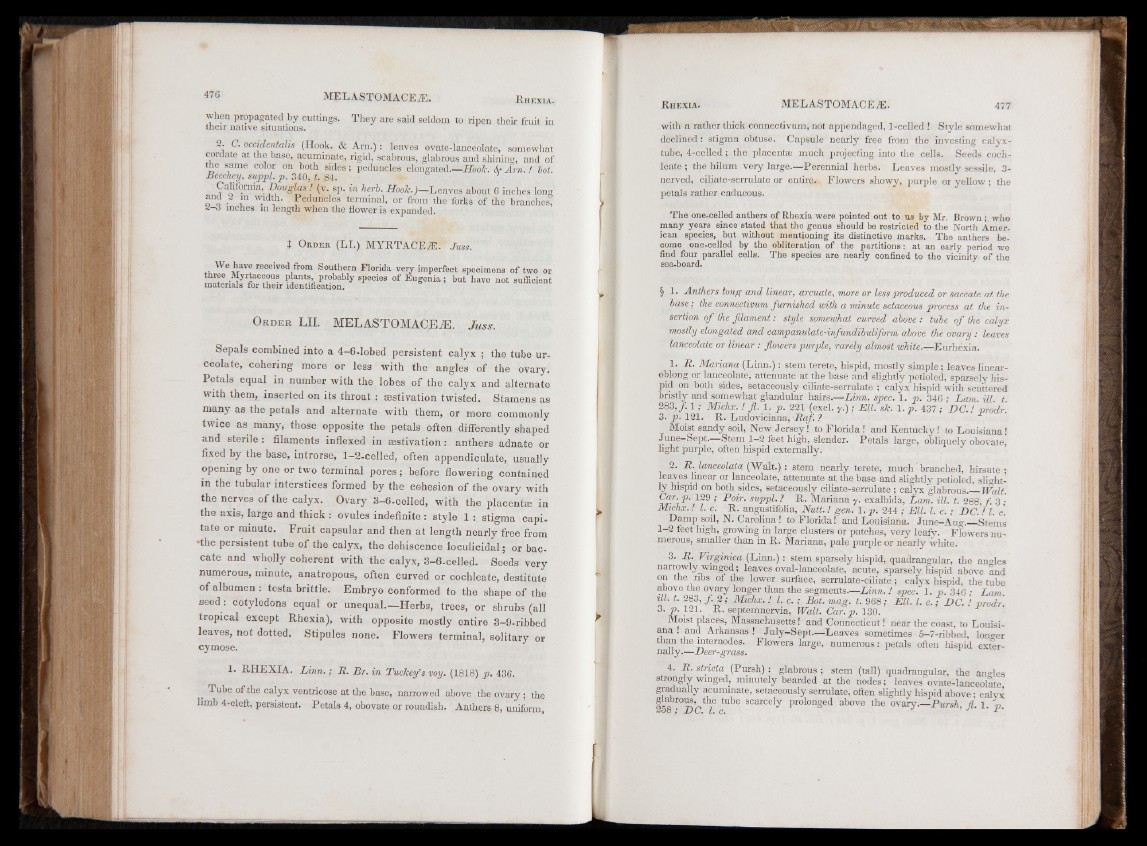
when propagated by cuttings. They are said seldom to ripen their fruit in
their native situations.
2. C. occidentalis (Hook. & Am .): leaves ovate-lanceolate, somewhat
cordate at the base, acuminate, rigid, scabrous, glabrous and shining, and of
the same color on both sides; peduncles elongated— Hook. &■ A m . ! bot.
Beecliey, suppl. p. 340, t. 84.
California, Douglas ! (v. sp. in herb. Hook.)—Leaves about 6 inches long
and 2 m width. Peduncles terminal, or from the forks of the branches,
2-3 inches m length when the flower is expanded.
t Order (LI.) MYRTACEiE. Juss.
. 1. WenhraV? reoeived/ rom Southern Florida very imperfect specimens of two or
three Myrtaceous plants, probably species of Eugenia; but have not sufficient
materials for their identification.
O r d e r L II. MELASTOMACEiE. J u s s .
Sepals combined into a 4-6-lobed persistent calyx ; the tube ur-
ceolate, cohering more or less with the angles of the ovary.
Petals equal in number with the lobes of the calyx and alternate
with them, inserted on its throat : aestivation twisted. Stamens as
many as the petals and alternate with them, or more commonly
twice as many, those opposite the petals often differently shaped
and sterile : filaments inflexed in aestivation: anthers adnate or
fixed by the base, introrse, 1-2-celled, often appendiculate, usually
opening by one or two terminal pores; before flowering contained
in the tubular interstices formed by the cohesion of the ovary with
the nerves o f the calyx. Ovary 8-6-ceIled, with the placentae in
the axis, large and thick : ovules indefinite : style 1 : stigma capi-
tate or minute. Fru it capsular and then a t length nearly free from
•the persistent tube of the calyx, the dehiscence loculicidal; or bac-
cate and wholly coherent with the calyx, 3-6-celIed. Seeds very
numerous, minute, anatropous, often curved or cochleate, destitute
o f albumen : testa brittle. Embryo conformed to the shape o f the
seed: cotyledons equal or unequal.—Herbs, trees, or shrubs (all
tropical except Rhexia), with opposite mostly entire 3—9-ribbed
leaves, not dotted. Stipules none. Flowers terminal, solitary or
cymose.
1. RHEXIA. L in n .; R. Br. in Tuckey’s very. (1818) p. 436.
Tube of the calyx ventricose at the base, narrowed above the ovary; the
limb 4-eleft, persistent. Petals 4, obovate or roundish. Anthers 8, uniform,
with a rather thick connectivum, not appendaged, 1-celled ! Style somewhat
declined: stigma obtuse. Capsule nearly free from the investing calyx-
tube, 4-celled; the placentae much projecting into the cells. Seeds cochleate
; the hilum very large.—Perennial herbs. Leaves mostly sessile, 3-
nerved, ciliate-serrulate or entire. Flowers showy, purple or yellow; the
petals rather caducous.
The one-celled anthers of Rhexia were pointed out to us by Mr. Brown ; who
many years since stated that the genus should be restricted to the North American
species, but without mentioning its distinctive marks. The anthers become
one-celled by the obliteration of the partitions: at an early period we
find four parallel cells. The species are nearly confined to the vicinity of the
sea-board.
§ 1. Anthers long and linear, arcuate, more or less produced or saccate at the
base; the connectivum furnished with a minute setaceous process at the insertion
of the filament: style somewhat curved above : tube of the calyx
mostly elongated and campanulate-infundibuliform above the ovary: leaves
lanceolate or linear : flowers purple, rarely almost white.—Eurhexia.
_ \-----------/ ’ ---------------- rriOOUJ , J.CCI V Co lL U C c L L -
oblong or lanceolate, attenuate at the base and slightly petioled, sparsely hispid
on both sides, setaceously ciliate-serrulate ; calyx hispid with scattered
bristly and somewhat glandular hairs.—Linn. spec. 1. p. 346 ; Lam. ill. t.
2 83,/. 1 ; Michx. ! fl. 1. p. 221 (excl. y.) ; Ell. sk. 1. p. 437; D C .! -prodr.
3. p. 121. R. Ludoviciana, Raf. ?
Moist sandy soil, New Jersey! to Florida ! and Kentucky! to Louisiana!
June-Sept.—Stem 1-2 feet high, slender. Petals large, obliquely obovate!
light purple, often hispid externally.
2. R.lanceolata (Walt.): stem nearly terete, much ’ branched, hirsute-
leaves linear or lanceolate, attenuate at the base and slightly petioled, slightly
hispid on both sides, setaceously ciliate-serrulate ; calyx glabrous__Walt.
Car-P- 129 ,- Poir. suppl. ? R. Mariana y. exalbida, Lam. ill. t. 288, f. 3 •
Michx.! 1. c. R. angustifolia, Nutt.! gen. 1. p. 244 ; Ell. 1. c. ; DC. f l . c.
Damp soil, N. Carolina! to Florida! and Louisiana. June-Aug.__Stems
1-2 feet high, growing in large clusters or patches, very leafy. Flowers numerous,
smaller than in R. Manana, pale purple or nearly white.
\------------/ ---------T cnuguicU., tile angles
narrowly winged; leaves oval-lanceolate, acute, sparsely hispid above and
° f tlie nbs ° f Iff lower surface, serrulate-ciliate; calyx hispid, the tube
above the ovary longer than the segments.—Linn. ! spec. 1. p. 346 ; Lam
ill. t. 283, ƒ. 2 ; Michx. ! 1. c. ; Bot. mag. t. 968; EU. 1. c .; DC. ! prodr.
3. p. 121. R. septemnervia, Walt. Car. p. 130.
Moist places, Massachusetts! and Connecticut! near the coast, to Louisiana
. and Arkansas ! July-Sept.—Leaves sometimes 5-7-ribbed, longer
than the mtemodes. Flowers large, numerous: petals often hispid externally.—
Deer-grass.
4. R . stricta (Pursh) : glabrous ; stem (tall) quadrangular, the angles
strongly winged, minutely bearded at the nodes; leaves ovate-lanceollte
gradually acuminate, setaceously serrulate, often slightly hispid above - calyx
glabrous, the tube scarcely prolonged above the ovary— Pursh, fl. 1. p,
2 0 8 ; DC. 1. c. . ’ j r '